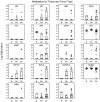Quantitative methylation profiles for multiple tumor suppressor gene promoters in salivary gland tumors
- PMID: 20520817
- PMCID: PMC2877085
- DOI: 10.1371/journal.pone.0010828
Quantitative methylation profiles for multiple tumor suppressor gene promoters in salivary gland tumors
Abstract
Background: Methylation profiling of tumor suppressor gene (TSGs) promoters is quickly becoming a powerful diagnostic tool for the early detection, prognosis, and even prediction of clinical response to treatment. Few studies address this in salivary gland tumors (SGTs); hence the promoter methylation profile of various TSGs was quantitatively assessed in primary SGT tissue to determine if tumor-specific alterations could be detected.
Methodology: DNA isolated from 78 tumor and 17 normal parotid gland specimens was assayed for promoter methylation status of 19 TSGs by fluorescence-based, quantitative methylation-specific PCR (qMSP). The data were utilized in a binary fashion as well as quantitatively (using a methylation quotient) allowing for better profiling and interpretation of results.
Principal findings: The average number of methylation events across the studied genes was highest in salivary duct carcinoma (SDC), with a methylation value of 9.6, compared to the normal 4.5 (p<0.0003). There was a variable frequency and individual methylation quotient detected, depending on the TSG and the tumor type. When comparing normal, benign, and malignant SGTs, there was a statistically significant trend for increasing methylation in APC, Mint 1, PGP9.5, RAR-beta, and Timp3.
Conclusions/significance: Screening promoter methylation profiles in SGTs showed considerable heterogeneity. The methylation status of certain markers was surprisingly high in even normal salivary tissue, confirming the need for such controls. Several TSGs were found to be associated with malignant SGTs, especially SDC. Further study is needed to evaluate the potential use of these associations in the detection, prognosis, and therapeutic outcome of these rare tumors.
Conflict of interest statement
Figures
Similar articles
-
Identification of methylated genes in salivary gland adenoid cystic carcinoma xenografts using global demethylation and methylation microarray screening.Int J Oncol. 2016 Jul;49(1):225-34. doi: 10.3892/ijo.2016.3532. Epub 2016 May 18. Int J Oncol. 2016. PMID: 27212063 Free PMC article.
-
Quantitative promoter methylation differentiates carcinoma ex pleomorphic adenoma from pleomorphic salivary adenoma.Br J Cancer. 2010 Dec 7;103(12):1846-51. doi: 10.1038/sj.bjc.6605953. Epub 2010 Nov 9. Br J Cancer. 2010. PMID: 21063414 Free PMC article.
-
Implications of methylation patterns of cancer genes in salivary gland tumors.Clin Cancer Res. 2006 Dec 15;12(24):7353-8. doi: 10.1158/1078-0432.CCR-06-1272. Clin Cancer Res. 2006. PMID: 17189407
-
Epigenetic alterations in salivary gland tumors.Oral Dis. 2020 Nov;26(8):1610-1618. doi: 10.1111/odi.13253. Epub 2020 Jan 22. Oral Dis. 2020. PMID: 31829479 Review.
-
Update in salivary gland cytopathology: Recent molecular advances and diagnostic applications.Semin Diagn Pathol. 2015 Jul;32(4):264-74. doi: 10.1053/j.semdp.2014.12.008. Epub 2014 Dec 19. Semin Diagn Pathol. 2015. PMID: 25613003 Review.
Cited by
-
Integrated, genome-wide screening for hypomethylated oncogenes in salivary gland adenoid cystic carcinoma.Clin Cancer Res. 2011 Jul 1;17(13):4320-30. doi: 10.1158/1078-0432.CCR-10-2992. Epub 2011 May 6. Clin Cancer Res. 2011. PMID: 21551254 Free PMC article.
-
Molecular biology of adenoid cystic carcinoma.Head Neck. 2012 Nov;34(11):1665-77. doi: 10.1002/hed.21849. Epub 2011 Oct 17. Head Neck. 2012. PMID: 22006498 Free PMC article. Review.
-
Salivary gland carcinomas.Oral Maxillofac Surg. 2012 Sep;16(3):267-83. doi: 10.1007/s10006-012-0350-9. Epub 2012 Jul 29. Oral Maxillofac Surg. 2012. PMID: 22842859 Review.
-
Salivary gland carcinoma: Prediction of cancer death risk based on apparent diffusion coefficient histogram profiles.PLoS One. 2018 Jul 5;13(7):e0200291. doi: 10.1371/journal.pone.0200291. eCollection 2018. PLoS One. 2018. PMID: 29975742 Free PMC article.
-
Salivary gland cancers: biology and molecular targets for therapy.Curr Oncol Rep. 2012 Apr;14(2):166-74. doi: 10.1007/s11912-012-0220-5. Curr Oncol Rep. 2012. PMID: 22246609
References
-
- Johns ME, Goldsmith MM. Incidence, diagnosis, and classification of salivary gland tumors. Part 1. Oncology (Williston Park) 1989;3:47–56; discussion 56, 58, 62. - PubMed
-
- Johns ME, Goldsmith MM. Current management of salivary gland tumors. Part 2. Oncology (Williston Park) 1989;3:85–91; discussion 94, 99. - PubMed
-
- Lalami Y, Vereecken P, Dequanter D, Lothaire P, Awada A. Salivary glands carcinomas, paranasal sinus cancers and melanoma of the head and neck: an update about rare but challenging tumors. Curr Opin Oncol. 2006;18:258–265. - PubMed
-
- Zhang CY, Mao L, Li L, Tian Z, Zhou XJ, et al. Promoter methylation as a common mechanism for inactivating E-cadherin in human salivary gland adenoid cystic carcinoma. Cancer. 2007;110:87–95. - PubMed
-
- Kishi M, Nakamura M, Nishimine M, Ikuta M, Kirita T, et al. Genetic and epigenetic alteration profiles for multiple genes in salivary gland carcinomas. Oral Oncol. 2005;41:161–169. - PubMed
Publication types
MeSH terms
Substances
Grants and funding
LinkOut - more resources
Full Text Sources
Other Literature Sources
Medical
Miscellaneous


